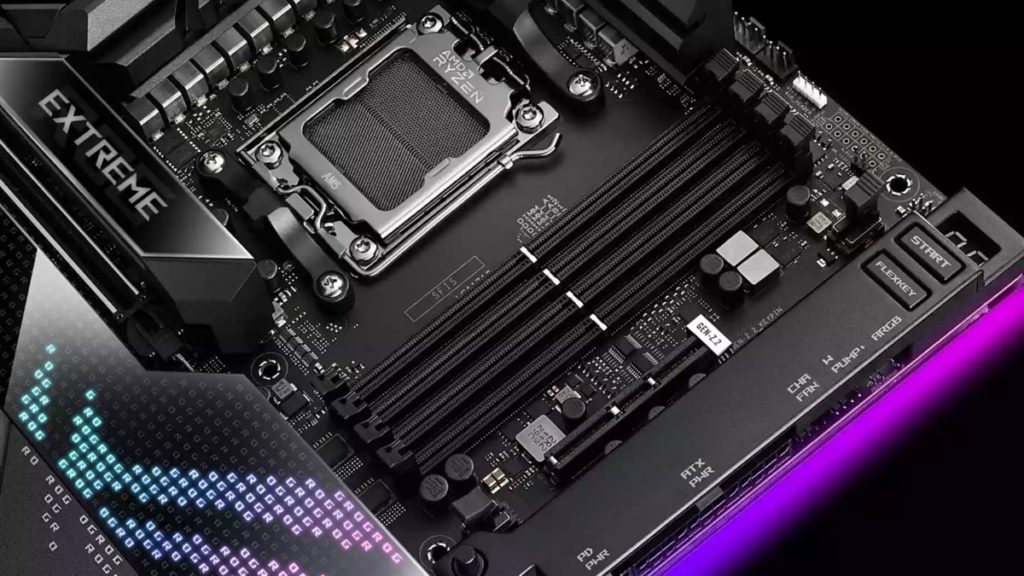
ASUS has announced the new Precision Boost Overdrive (PBO) enhancement, an exclusive temperature control feature for its range of X670 and B650 motherboards designed for AMD Ryzen 7000 series processors. The feature allows users to easily balance the thermals and performance of their new CPUs, allowing them to “dramatically” reduce their temperatures with just a few clicks and possibly increase performance and reduce fan noise in the process. ASUS X670 and B650 motherboard owners can try out the new Precision Boost Overdrive (PBO) enhancement now by downloading the proper BIOS update below.
BIOS update:
| X670E/X670 motherboard model | BIOS Version |
|---|---|
| ROG Crosshair X670E Extreme | 0705 |
| ROG Crosshair X670E Hero | 0705 |
| ROG Crosshair X670E Gene | 0705 |
| ROG Strix X670E-E Gaming WiFi | 0705 |
| ROG Strix X670E-F Gaming WiFi | 0705 |
| ROG Strix X670E-A Gaming WiFi | 0705 |
| ROG Strix X670E-I Gaming WiFi | 0805 |
| ProArt X670E-Creator WiFi | 0705 |
| TUF Gaming X670E-Plus WiFi | 0805 |
| TUF Gaming X670E-Plus | 0805 |
| Prime X670E-Pro WiFi | 0805 |
| Prime X670-P WiFi | 0805 |
| Prime X670-P | 0805 |
| B650E/B650 motherboard model | BIOS Version |
| ROG Strix B650E-E Gaming WiFi | 0805 |
| ROG Strix B650E-F Gaming WiFi | 0805 |
| ROG Strix B650-A Gaming WiFi | 0805 |
| ROG Strix B650E-I Gaming WiFi | 0805 |
| ProArt B650-Creator | 0212 (Coming soon) |
| TUF Gaming B650-Plus WiFi | 0805 |
| B650E/B650 motherboard model | BIOS Version |
| TUF Gaming B650-Plus | 0805 |
| TUF Gaming B650M-Plus WiFi | 0805 |
| TUF Gaming B650M-Plus | 0805 |
| Prime B650-Plus | 0805 |
| Prime B650M-A AX | 0805 |
| Prime B650M-A WiFi | 0805 |
| Prime B650M-A | 0805 (Coming soon) |

ASUS on how to activate the PBO enhancement in the BIOS:
If users need help with the following process, view the official ASUS Support video or follow the step-by-step instructions. The basic steps for enabling the PBO enhancement are as follows:
Download the BIOS update containing the PBO enhancement feature from the ASUS support page, then extract the contents of the ZIP archive. Double-click on the BIOS Renamer tool that was extracted along with the firmware file, which will automatically convert this update to the proper format with the CAP file extension. Then copy or move the renamed file with the CAP extension into the root directory of a USB drive.
To begin the update process, shut off the PC, but leave it connected to power. Then plug the USB drive into the port on the rear I/O panel of the motherboard labeled ‘BIOS’. Hold the nearby BIOS Flashback button down for three seconds, or until the Flashback LED has blinked three times. This will indicate that the update has started. The light will then blink slowly for the next several minutes. When this blinking stops, the update process has completed. At this point, remove the flash drive, turn the PC back on, and the update process will automatically take users to the motherboard’s UEFI BIOS interface, where users will have the option to enable the PBO enhancement.
Once users have entered into the UEFI BIOS interface, activate Advanced mode. Then navigate to the Extreme Tweaker tab and select Precision Boost Overdrive.
In the menu that opens, select Enhancement from the Precision Boost Overdrive dropdown. Then select one of the three preset thermal limits. Level 1 will set the maximum target temperature to 90°C, a modest step down from the default 95°C. Levels 2 and 3 lower the maximum CPU temperatures more aggressively, down to 80°C and 70°C, respectively.
Once the desired level has been chosen, users can save this setting and exit the BIOS.
ASUS on expected performance with the PBO enhancement:
Several factors will affect how CPU performance may change after activating the PBO enhancement. The model of CPU and motherboard will have the most influence, followed by the cooling solution. The level setting of the PBO enhancement will also have a significant effect, as well as factors like ambient temperatures and the characteristics of other components in the machine.
For an idea of what kind of performance changes to expect with the PBO enhancement, ASUS conducted its own tests using four different AMD Ryzen CPUs. Each chip was tested using a 280 mm AIO liquid cooler. For comparison, ASUS also tested each chip using the default PBO settings.
Starting at the top with the AMD Ryzen 9 7950X and the Ryzen 9 7900X: At default settings, this system earned a score of 37,811 in Cinebench R23’s multi-core test. Activating PBO enhancement Level 1 reduced temperatures by 5°C while actually increasing performance — because with this PBO enhancement setting, users are not only setting a temperature limit, they are activating voltage and PBO optimizations. Setting PBO enhancement to Level 3 reduced performance by only 3.5% while dropping maximum temperatures by 25°C. That is a tradeoff that many enthusiasts would happily make.
The benefits of the PBO enhancement are even more pronounced with the AMD Ryzen 5 7600X. Setting PBO enhancement to Level 3 — the most aggressive option — drops observed CPU temperatures by a full 20°C without changing performance in this test by more than 0.003%. Users of this chip can reasonably expect that PBO enhancement Level 3 will significantly lower CPU temperatures without noticeably affecting system performance.
